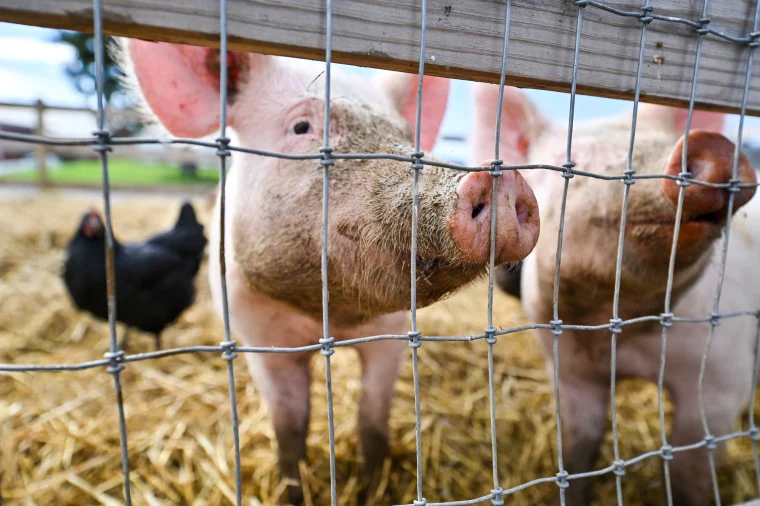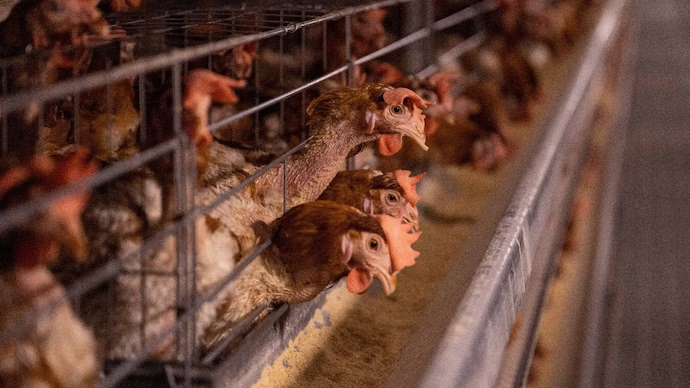Bird Flu Found in Oregon Pig Sparks Warnings and Nationwide Surveillance Amid Growing Concerns
In a rare and concerning development, the U.S. Department of Agriculture (USDA) confirmed on Wednesday that a backyard pig in Oregon tested positive for H5N1 bird flu. This marks the first detection of avian influenza in swine within the United States, raising alarms due to pigs’ ability to co-host both bird and human influenza viruses, potentially creating new hybrid strains that could pose an increased risk to human health. Although the USDA assured the public that there is no immediate threat to the nation’s pork supply and maintains that the overall risk to human health remains low, the news has intensified calls for heightened biosecurity measures among pig farmers and has driven the USDA to expand its bird flu surveillance.
Pigs are unique in the world of influenza transmission because they can be infected with both bird flu and human flu viruses, creating what scientists call a “mixing vessel” for virus reassortment. In this process, viral genes from bird flu and human flu can combine within a pig host, leading to the emergence of a new strain with unpredictable virulence and transmissibility. Richard Webby, a flu expert at St. Jude Children’s Research Hospital and part of the World Health Organization (WHO) team studying flu in animals, explained that pigs have previously contributed to significant flu outbreaks, including the H1N1 pandemic in 2009-2010.

“Pigs are particularly suited for influenza transmission, and if this virus starts transmitting in pigs, that absolutely increases the risk,” Webby commented. However, he emphasized that this particular detection, which occurred on a small farm in Oregon, presents less of a risk than an outbreak in a larger, commercial pig operation would. Still, the potential for gene swapping remains a critical concern that warrants close monitoring.
In response to the Oregon case, USDA officials have imposed a quarantine on the affected farm. Other animals on the farm, including sheep and goats, are under strict surveillance, and both poultry and pigs have been culled to prevent any spread of the virus. Two additional pigs from the property are currently awaiting test results, according to USDA. Importantly, the agency determined that the infection likely originated from wild birds rather than from direct exposure to poultry or dairy sources. Wild bird migrations have been widely acknowledged as vectors for spreading bird flu, with outbreaks affecting poultry flocks and some cattle herds across the United States over the past year.
To mitigate the risk of further outbreaks, the USDA is enhancing its bird flu surveillance by expanding testing protocols across the country, including implementing routine bird flu monitoring in bulk milk supplies. This new initiative is part of a broader strategy to ensure early detection and tracking of the virus within dairy and bovine populations, Agriculture Secretary Tom Vilsack said in a recent interview.
“While it’s a different variation of the virus and it is tied to wild birds, it is a factor to make sure that we understand and appreciate exactly where the virus is in dairy and in bovine,” Vilsack noted.
The discovery of bird flu in a pig has also influenced lean hog futures, with prices at the Chicago Mercantile Exchange seeing downward pressure following the announcement. Although the affected pig was not destined for the commercial food market, the incident has nonetheless raised concerns over the potential economic impact if similar cases were to spread within commercial pig farms.
Historically, flu outbreaks in livestock have triggered significant market shifts, impacting supply chains and resulting in price volatility. While USDA officials have tried to reassure the public regarding the pork supply, market analysts are keeping a close eye on the situation, recognizing the potential for financial ripple effects in the agricultural and food sectors if bird flu were to establish a foothold in more pig populations.
The Oregon backyard farm in question had a unique setup where pigs and poultry shared water sources, housing, and equipment. According to USDA, these shared resources can serve as transmission pathways for avian influenza between animals, a phenomenon observed in outbreaks across other states. Proximity between different animal species on farms, especially in backyard or small-scale operations, often creates conditions conducive to cross-species transmission of viruses.
Marie Culhane, a veterinary professor specializing in flu viruses in swine at the University of Minnesota, urged pig farmers to adopt proactive measures in light of the recent finding. “People need to start increasing their plans to deal with it if it should happen in another herd and another herd,” Culhane said. She added that pigs have a high capacity to contract influenza viruses and serve as reservoirs for viral recombination, further highlighting the importance of vigilance and biosecurity.
This sentiment has prompted calls for greater awareness among pig farmers to monitor for symptoms of avian influenza in their herds. While the risk of widespread transmission among pigs in the U.S. is currently believed to be low, this detection serves as a reminder of the critical need for biosecurity practices, such as isolating animals, sanitizing equipment, and limiting exposure to wild birds or other potential carriers.
The current avian influenza outbreak has been deemed the worst in U.S. history, with over 100 million poultry birds affected since it began in 2022. This outbreak has not only disrupted poultry markets but also raised public health concerns. Bird flu’s rapid spread has already led to 36 human infections this year, with nearly all cases involving farm workers who had direct contact with infected animals. This demonstrates that while the risk to the general public is low, those working directly with infected animals are at a higher risk of infection.
Given the highly pathogenic nature of this virus, agricultural experts worry that if bird flu were to become established in a new host, such as pigs, the disease could evolve further, creating an even more robust zoonotic threat.

“Pigs are just really good at picking up influenza viruses,” Culhane noted, underscoring the importance of quick action to contain this virus at the source.
The potential for bird flu to mutate in a pig and acquire genes that enable easier transmission to humans adds a new dimension of urgency for health officials worldwide. The evolution of flu strains in animal hosts has long been recognized as a driving factor behind pandemic-level threats, with the 2009 H1N1 flu serving as a stark reminder of how quickly a virus can cross species boundaries and adapt to human hosts.
The USDA’s decision to broaden its bird flu monitoring, including testing of bulk milk nationwide, represents an essential step in understanding the virus’s spread across different agricultural sectors. By expanding the scope of testing to dairy and bovine animals, the agency aims to track potential cross-species infections more accurately and identify transmission patterns early on. This move reflects a recognition of the broader ecosystem’s role in virus transmission, with Agriculture Secretary Vilsack emphasizing the importance of a comprehensive approach to monitor and contain the virus.
Wild birds, a primary source of bird flu, have been migrating across the continent and contributing to outbreaks in multiple animal populations, from poultry to swine and cattle. Recognizing the interconnections within ecosystems, USDA officials believe that tracking the virus across various animal hosts, including dairy herds, will provide a clearer picture of the bird flu’s reach and potential implications.
The Oregon bird flu case is a wake-up call for the agricultural industry, reinforcing the importance of preventive measures and readiness to tackle viral outbreaks that may cross species barriers. With influenza viruses continually evolving, the possibility of a new, more infectious strain always looms on the horizon. While the immediate public health risk is currently considered low, the situation in Oregon highlights the unpredictable nature of zoonotic viruses and the ongoing need for robust biosecurity practices and comprehensive surveillance.
The collaborative approach between government agencies, veterinary experts, and farmers is crucial in preventing further transmission and safeguarding both animal and human health. For pig farmers and backyard livestock owners, this case serves as a reminder to remain vigilant, keep their animals safe, and prevent wild birds from coming into contact with livestock.
With more than 100 million poultry birds already affected in this unprecedented bird flu outbreak, agricultural authorities are prioritizing early detection, rapid containment, and ongoing research to understand the virus better. As we move forward, strengthening these protocols will be essential to prevent further escalation and to protect public health from the threat posed by bird flu and other zoonotic viruses.




